Last week in “Volatility Crushed” we talked about a coming volatility spike and sure enough VIX spiked to over 20 from the 15 handle in a matter of days, only to be crushed again.
Thursday’s one hour 1.7% dip on SPX was once again ferociously bought and new highs have once again ensued, no matter what the internal picture of the market may be, which continues to rally irrespective of the lack of participation underneath the surface.
On Sunday morning, we got a taste of this:

But that’s neither here nor there and won’t matter until it does.
More impressive to me are the fingerprints left behind by each VIX spike and how these spikes fit inside the larger volatility structures we’ve been watching build for months.
Many of you will be familiar with the larger VIX structure I’ve been pointing to. It remains alive and well:

What’s fascinating is that this main structure can be found across many other volatility instruments.
Take the original VIX formula, the VXO:

Note where it stopped last week: Right at the top of the trendline. The message: This line matters big time and it has mattered since the March 2020 lows.
Technicians know that the more often a trendline gets tagged, the weaker it becomes suggesting that one of these days volatility will burst through the confines of its prison.
Even more fascinating, the same trendline behavior was observed last week at the same time on small caps (IWM):
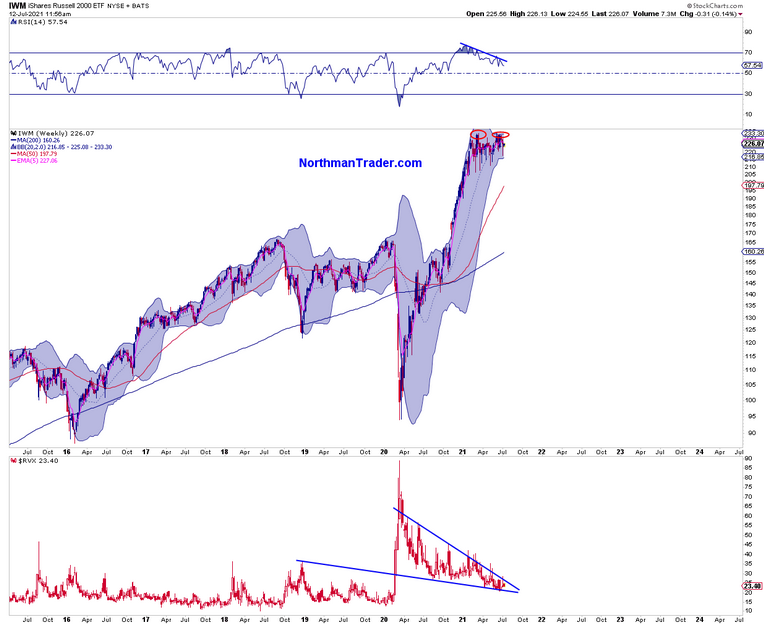
Its underling volatility component, RVX, also stopped dead in its tracks at the trendline sending the same message.
And lo and behold, Tech, up 8 weeks in a row and going on 9 keeps showing a very similar structure which is extremely clean:
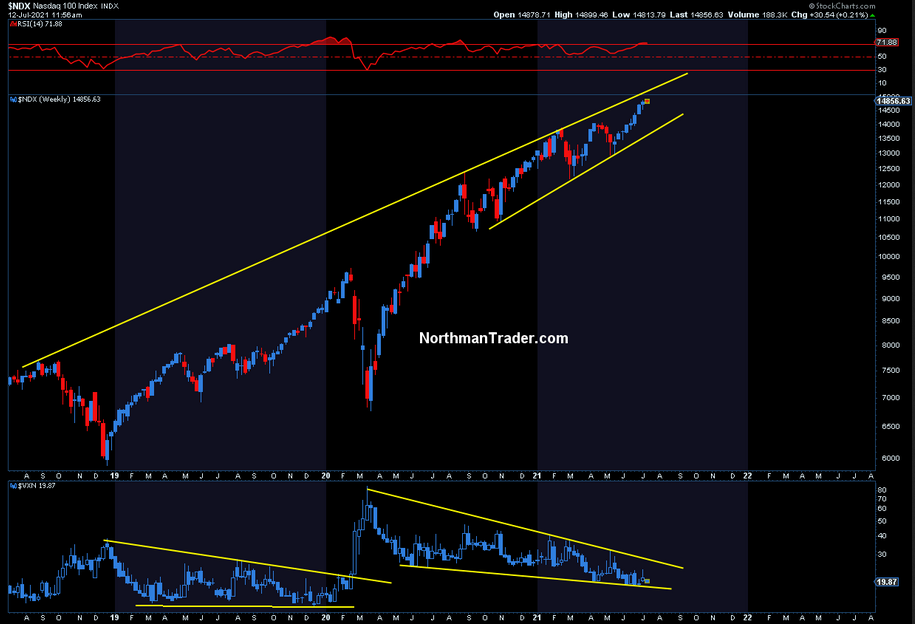
As readers know, I haven’t touched or changed these trendlines in months; price keeps respecting these structures cleanly, hence they matter from my perspective and they keep building for a coming volatility event.
Also of interest: all of these volatility structures are forming on top of the previous ones in the years before. Which is surprising considering the high price levels we’re seeing and the pronounced calm in markets.
Now, as I’ve said before, even at the beginning of the year, all this can take months to play out, but the message of all these patterns remains the same: A big volatility spike is coming and this ongoing one way market strength, ever so desperate to buy every single little dip, continues to disconnect markets ever further from historic trends.
If we’ve learned one thing over the past years it’s this: The extremes become ever more extreme, and when things are extremely stretched the reaction to the downside is often much greater than anyone can imagine. Nobody will give us a day and time as tops are processes, but the underlying picture keeps bubbling as it shows ever more weakening beneath the surface:

And as you can see from this chart history, SPX continuing to make new highs on weakening internals and momentum, can end up being extremely deceiving.
The broader message: As the volatility structures keep tightening across the board the next big spike may not stop at the respective trendlines. How dramatic such a move (when it comes) will end up being will depend on a lot of factors, not only on technicals, but also positioning.
And it’s fair to say we’ve never seen such a one way positioned market:
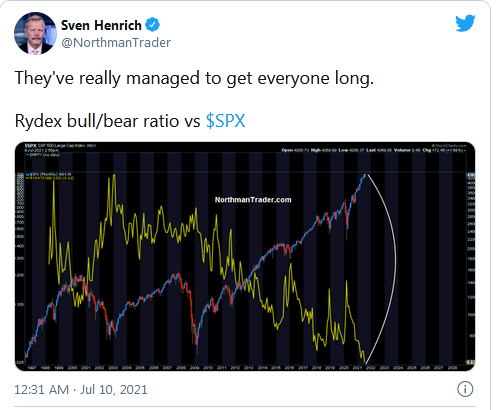
There are no bears, only bulls. Who’s gonna cover their shorts and buy stocks during the big volatility event if everybody is already in? An academic question at best at the moment as nobody can even imagine any downside in markets that now print record highs almost every day.
I can’t give you a day and time, but I can give you the structures above and you can choose to ignore them of course. What they tell me is this: It’s coming, just a matter of time and perhaps the right trigger, and then downside, currently so elusive, may come faster and deeper than anyone expects.
I’ll leave you with one historical example, as a reference: 1998. It was relentless on the way up out of the gate in the early part of the year, consolidated for a few weeks and then ripped higher into the summer. Does that script sound familiar? It should, as it basically reflects the actions we’ve seen so far this year. What happened then?
It peaked ironically in July and then proceeded to correct by over 20% before setting up for a rip roaring rally into the end of that year:
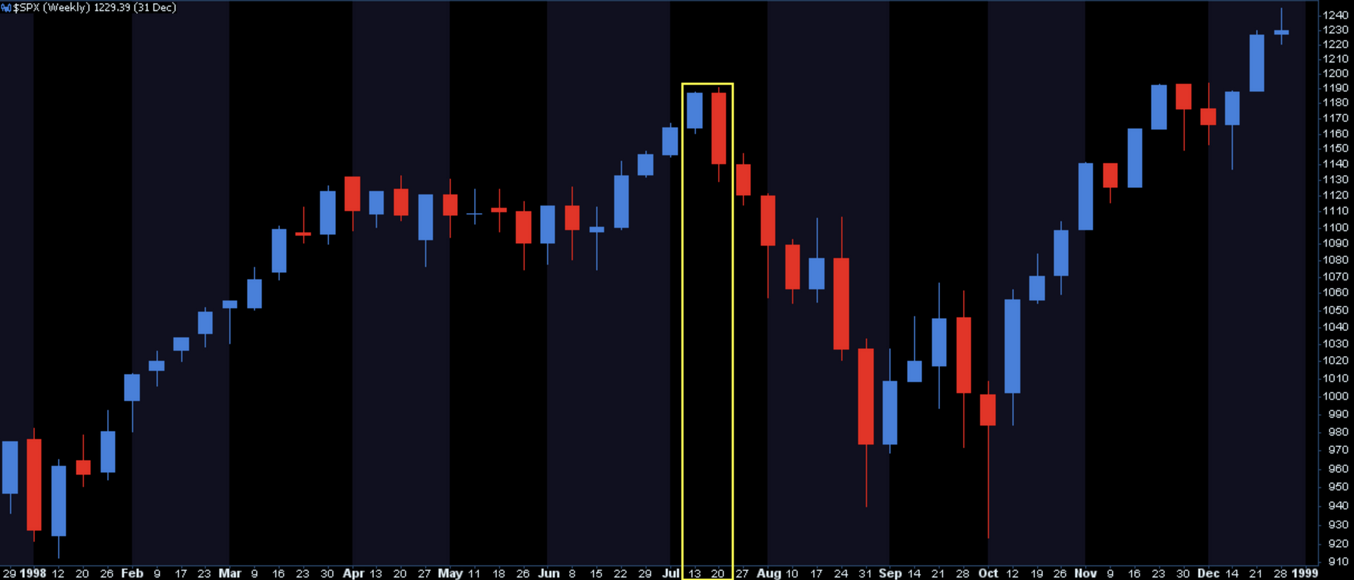
History never repeats, but sometimes it rhymes? We’ll find out. A 20%+ correction would feel like Armageddon right now and this market may not correct 20% this year, but frankly, from my lone perch, it would be healthy in cleansing out the speculative excess and likely set up for a major buy.
But for now markets can’t even manage a 2% pullback before the panic buyers show up (as we saw last week).
One day the character of this market will change, and when it does it will happen suddenly, and when it does participants may perhaps find themselves psychologically unprepared:
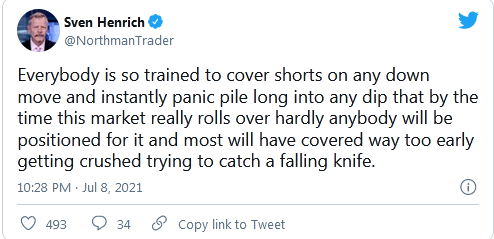
The trick will be to recognize when things have changed and these volatility structures above give us a clear guide as to when that moment has arrived: When the trendlines are no longer lines of resistance.
